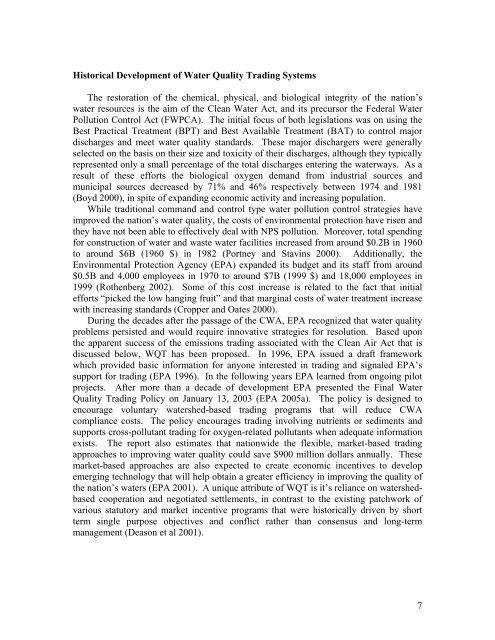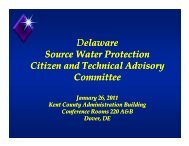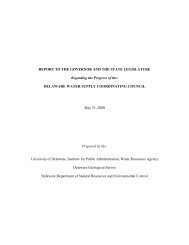Water Quality Trading in the Lower Delaware River Basin: A ...
Water Quality Trading in the Lower Delaware River Basin: A ...
Water Quality Trading in the Lower Delaware River Basin: A ...
You also want an ePaper? Increase the reach of your titles
YUMPU automatically turns print PDFs into web optimized ePapers that Google loves.
Historical Development of <strong>Water</strong> <strong>Quality</strong> <strong>Trad<strong>in</strong>g</strong> Systems<br />
The restoration of <strong>the</strong> chemical, physical, and biological <strong>in</strong>tegrity of <strong>the</strong> nation’s<br />
water resources is <strong>the</strong> aim of <strong>the</strong> Clean <strong>Water</strong> Act, and its precursor <strong>the</strong> Federal <strong>Water</strong><br />
Pollution Control Act (FWPCA). The <strong>in</strong>itial focus of both legislations was on us<strong>in</strong>g <strong>the</strong><br />
Best Practical Treatment (BPT) and Best Available Treatment (BAT) to control major<br />
discharges and meet water quality standards. These major dischargers were generally<br />
selected on <strong>the</strong> basis on <strong>the</strong>ir size and toxicity of <strong>the</strong>ir discharges, although <strong>the</strong>y typically<br />
represented only a small percentage of <strong>the</strong> total discharges enter<strong>in</strong>g <strong>the</strong> waterways. As a<br />
result of <strong>the</strong>se efforts <strong>the</strong> biological oxygen demand from <strong>in</strong>dustrial sources and<br />
municipal sources decreased by 71% and 46% respectively between 1974 and 1981<br />
(Boyd 2000), <strong>in</strong> spite of expand<strong>in</strong>g economic activity and <strong>in</strong>creas<strong>in</strong>g population.<br />
While traditional command and control type water pollution control strategies have<br />
improved <strong>the</strong> nation’s water quality, <strong>the</strong> costs of environmental protection have risen and<br />
<strong>the</strong>y have not been able to effectively deal with NPS pollution. Moreover, total spend<strong>in</strong>g<br />
for construction of water and waste water facilities <strong>in</strong>creased from around $0.2B <strong>in</strong> 1960<br />
to around $6B (1960 $) <strong>in</strong> 1982 (Portney and Stav<strong>in</strong>s 2000). Additionally, <strong>the</strong><br />
Environmental Protection Agency (EPA) expanded its budget and its staff from around<br />
$0.5B and 4,000 employees <strong>in</strong> 1970 to around $7B (1999 $) and 18,000 employees <strong>in</strong><br />
1999 (Ro<strong>the</strong>nberg 2002). Some of this cost <strong>in</strong>crease is related to <strong>the</strong> fact that <strong>in</strong>itial<br />
efforts “picked <strong>the</strong> low hang<strong>in</strong>g fruit” and that marg<strong>in</strong>al costs of water treatment <strong>in</strong>crease<br />
with <strong>in</strong>creas<strong>in</strong>g standards (Cropper and Oates 2000).<br />
Dur<strong>in</strong>g <strong>the</strong> decades after <strong>the</strong> passage of <strong>the</strong> CWA, EPA recognized that water quality<br />
problems persisted and would require <strong>in</strong>novative strategies for resolution. Based upon<br />
<strong>the</strong> apparent success of <strong>the</strong> emissions trad<strong>in</strong>g associated with <strong>the</strong> Clean Air Act that is<br />
discussed below, WQT has been proposed. In 1996, EPA issued a draft framework<br />
which provided basic <strong>in</strong>formation for anyone <strong>in</strong>terested <strong>in</strong> trad<strong>in</strong>g and signaled EPA’s<br />
support for trad<strong>in</strong>g (EPA 1996). In <strong>the</strong> follow<strong>in</strong>g years EPA learned from ongo<strong>in</strong>g pilot<br />
projects. After more than a decade of development EPA presented <strong>the</strong> F<strong>in</strong>al <strong>Water</strong><br />
<strong>Quality</strong> <strong>Trad<strong>in</strong>g</strong> Policy on January 13, 2003 (EPA 2005a). The policy is designed to<br />
encourage voluntary watershed-based trad<strong>in</strong>g programs that will reduce CWA<br />
compliance costs. The policy encourages trad<strong>in</strong>g <strong>in</strong>volv<strong>in</strong>g nutrients or sediments and<br />
supports cross-pollutant trad<strong>in</strong>g for oxygen-related pollutants when adequate <strong>in</strong>formation<br />
exists. The report also estimates that nationwide <strong>the</strong> flexible, market-based trad<strong>in</strong>g<br />
approaches to improv<strong>in</strong>g water quality could save $900 million dollars annually. These<br />
market-based approaches are also expected to create economic <strong>in</strong>centives to develop<br />
emerg<strong>in</strong>g technology that will help obta<strong>in</strong> a greater efficiency <strong>in</strong> improv<strong>in</strong>g <strong>the</strong> quality of<br />
<strong>the</strong> nation’s waters (EPA 2001). A unique attribute of WQT is it’s reliance on watershedbased<br />
cooperation and negotiated settlements, <strong>in</strong> contrast to <strong>the</strong> exist<strong>in</strong>g patchwork of<br />
various statutory and market <strong>in</strong>centive programs that were historically driven by short<br />
term s<strong>in</strong>gle purpose objectives and conflict ra<strong>the</strong>r than consensus and long-term<br />
management (Deason et al 2001).<br />
7




